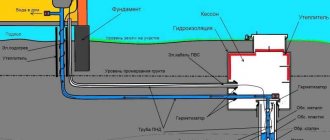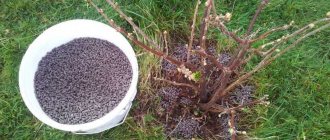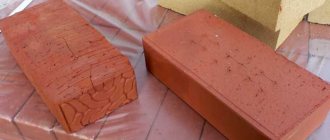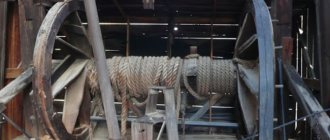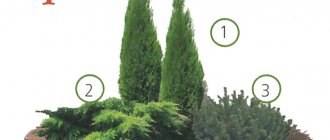A lawn is a must-have attribute of any garden space. It provides moisture, creates a microclimate, decorates and provides a background for all the compositions located behind it. It is pleasant to walk barefoot on well-groomed grass and evokes a lot of pleasant sensations. However, is it easy to grow lawn grass and then care for it? After all, like any other plant, it also requires some care. Let's try to figure this issue out together.
There are practically no gardens and summer cottages without lawns. Therefore, do not underestimate the importance of caring for it. But it should be remembered that maintaining it in decent shape is a troublesome and time-consuming task. Perhaps these tips will help you, and you will receive great pleasure not only from the well-groomed and beautiful appearance of your site.
How to sow lawn grass correctly
In order for your lawn to please you for many years after sowing, you need to take a very responsible approach to the initial stage - preparing the site for sowing seeds. And first of all, it is imperative to prepare a fertile mixture in a sufficiently large layer. It is best to do this with a cultivator to a depth of at least 30 cm, mixing the top fertile layer with a simple layer of sand and, preferably, manure. Or do it with a regular shovel.
The next step will be leveling the soil. This way you can remove all the irregularities. They do this by leveling the ground with a fan rake while simultaneously stepping back. This way the soil will remain level without any indentations from your footprints.
After which you need to water the soil for several days so that all the voids in it disappear. And only after that they roll the ground again with a heavy roller so that the soil becomes more dense and even. If you do not do this and sow the seeds on loose soil, then after several rains over time the lawn may become pitted and bumpy.

If you do not have the opportunity to purchase or rent such a skating rink, you can replace it with a homemade one using a heavy log.
When sowing seeds, it is necessary to take into account a point that few people pay attention to. During transportation, small seeds fall to the bottom of the bag, leaving only large ones at the top. Therefore, before sowing, they must be thoroughly mixed in a bag so that they are evenly distributed throughout the entire volume. Then, for example, pour the seeds in a mug into a separate container one by one from each bag and then mix them again. And only after such mixing can the seeds be sown.

Before sowing the seeds, loosen the soil again with a fan rake to a depth of 1 cm. It is better to sow the seeds manually or with a special diffuser. If you do this manually, according to the old-fashioned method, scatter the seeds while stepping back. This will allow you to see how often or rarely the seeds are scattered. The sowing rate is approximately 5-6 seeds per 1 square meter. cm.
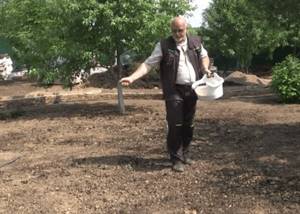
Weeds on the lawn that germinate before planting are best dug up immediately, with their roots. Most often this is quinoa, brought with fertile soil. Such weeds usually go away after 1-2 mowings. But if you haven’t sowed the area for a long time, then other weeds (dandelions, plantains, gooseberry) will sprout on it. Then, before sowing, use herbicides in advance and only after a few days you can sow the seeds.
Lawn care after planting
After sowing the seeds, the soil is rolled again with a roller, and then it needs to be watered. The water spray should be very fine. This helps to uniformly moisten the soil and prevent the seeds lying on the surface from being washed away.
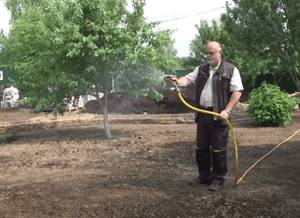
If the days are hot and dry, cover the seeded area with thin spunbond and water every evening. If it is not possible to cover with covering material, water the soil 2 times a day so that it does not dry out. The worst thing for germinating seeds is to dry out at the moment of germination.
When and how to fertilize your lawn?
All fertilizing of lawn grass is carried out after mowing. If the fertilizers are liquid and dissolve well, they can be diluted in a small amount of water and applied directly to the irrigation system.
Dry fertilizers are applied according to a different principle. First, you need to water the lawn, then wait until the grass leaves dry out. Only after this can fertilizer be applied. At the end, the lawn is watered again.
After applying dry fertilizers, the lawn must be watered
How to care for lawn grass in spring after winter
In spring, the lawn usually looks rather unpresentable. It's not scary, it's how he comes out of winter. All plants look like this after winter. With proper care, it will quickly acquire a beautiful appearance. The first step is to clean the area with a fan rake of all the debris left over from the winter. These are fallen leaves, pine needles, etc.
The next step is aerating the soil. After winter, the condition of the grass deteriorates. Lawn grass, consisting of perennial grasses, has a powerful root system, which, as it grows, forms a dense turf. Because of this, a sufficient amount of moisture, nutrients and oxygen does not reach the roots. As a result, the growth of the grass slows down, it becomes dull, yellowish appears on it, and bald spots form. To prevent this from happening, and to ensure that the lawn regains its green and attractive appearance, aeration is carried out.

Soil aeration is the piercing of the upper turfy layer of soil to a depth of approximately 10-15 cm. This improves gas exchange between atmospheric and soil oxygen, the soil will be ventilated, and nutrients can flow to the roots along with moisture. This will speed up the restoration of grass cover. Aeration of the site can be ordered from a specialized agency, but you can do it yourself.
To avoid damage to the cover, aeration is not carried out in hot weather.
Before aeration, it is necessary to first mow the grass to a level of 5 cm and remove weeds. Otherwise, after ventilation, the weeds will begin to grow even more. A few days before the procedure, if there is no rain, the soil should be well watered so that the soil becomes soft and pliable.
Piercing can be done using ordinary forks in cross rows at a distance of 3-4 cm to a depth of 10-15 cm. Nowadays you can purchase special linings with spikes that are worn on shoes. Then all that remains is to walk around the site for a while in these shoes.

But it is best to purchase special machines for this purpose. A few days after aerating the lawn
- feed with nitrogen fertilizers,
- Use a rake to smooth out the removed clods of earth,
- water it,
- re-sow the bald spots that appear with seeds.
A haircut
The next stage of care is mowing the lawn. It is carried out after 3-4 months from the day of planting, when a small bushiness has formed. The guideline for cutting can be the height of the grass. When the 9 cm mark is reached, the greens can be cut off.
Taller grass prevents sunlight from reaching the lower parts of the plants, causing their colors to fade. Therefore, it is important to mow the lawn on time.


Kerria or Keria: photo and description of the shrub, rules and subtleties of growing a plant with yellow flowers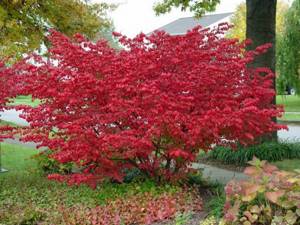
Ornamental shrubs in landscape design blooming in autumn
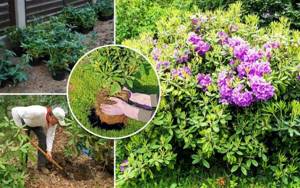
Autumn planting of shrubs: useful tips from experienced gardeners
When doing your first mowing, you should not cut the grass very short. After cutting, the vegetation will grow and take on a neat appearance.
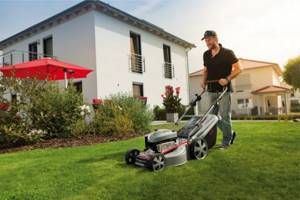
In addition to growing a green carpet yourself, you can resort to a ready-made solution - buy a rolled lawn. It is a natural covering in the form of a layer of earth with a turf of grass located on it.
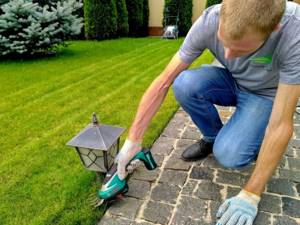
The advantage of this product is ease of use and quick results. Acclimatization of the lawn occurs 2 weeks after installation.

Summer lawn care (mowing, fertilizing, watering, weeding, aeration)
A haircut
When the lawn grows more than 10 cm, grass mowing is necessary. It is carried out with a lawn mower, adjusting the cutting height to 5 cm.

Top dressing
In the first half of summer, nitrogen fertilizers and watering are necessary for the good condition of the lawn. Nitrogen is necessary for plants to grow green mass. Used as nitrogen fertilizer
- ammonium nitrate,
- ammonium sulfate,
- urea (carbamide),
- nitrogen fertilizer Zelenit.
Application rate – 15-20 g per 1 square. m.
The lack of this element is manifested by the pale color of the grass, as well as the appearance of bald spots on the lawn. Excess, on the contrary, causes uncontrolled growth of grass with a dark green tint. The grass becomes brittle and the lawn loses its presentable appearance. Therefore, when using mineral nitrogen fertilizers, strictly follow the instructions for use and observe the suggested dosages.
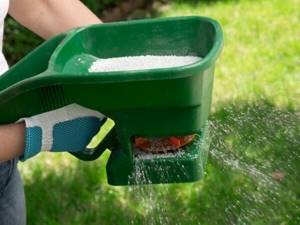
In addition to mineral nitrogen fertilizers, grass responds well to organic fertilizers. For this purpose, mullein and chicken droppings can be used. However, before using them, they must be properly diluted. Therefore, it is more rational to use complex organomineral fertilizers - Fertika, Agros, Lawn.
Twice during the summer the lawn is fed with potassium and phosphorus fertilizers. Consumption rate of superphosphate per 1 sq. m - 40-60 g, potassium sulfate - 25-30 g. In rainy summers, the fertilizer rate should be increased, since potassium is actively washed out of the soil with water. Among homemade fertilizers, it is good to use wood ash and herbal infusion.
Watering
This is the most important point in lawn care. Proper and timely irrigation will provide a beautiful and well-groomed appearance, stimulate plant growth, and create a favorable microclimate. Lack of moisture manifests itself as follows:
- grass leaves begin to curl;
- the grass takes a long time to rise after being pressed down;
- the grass withers and turns yellow;
- bald spots appear.
Lawns are watered using a rain hose, a pivot sprinkler, a rotary sprinkler, or automatic watering systems.

Watering is best done in the early morning. On a cool, windless morning before the heat sets in, the moisture on the leaves evaporates less and has time to dry before the sun rises high. If watering is carried out during the day, the remaining droplets of moisture can cause burns to the leaves. Daytime watering is best done on cloudy days or closer to autumn, when the sun is not so hot.
Evening watering is best done between 16:00 and 18:00. It is not recommended to water the lawn later. This is due to the fact that moisture from the leaves will not have time to evaporate at night, the plants will remain wet and this will contribute to the development of fungal diseases.
The frequency of watering in summer depends on soil type, root depth and weather. In dry and hot weather and in the southern regions of the country, you need to water the lawn daily. In the middle zone, where the weather is not so hot, watering can be carried out at least 2-3 times a week. On light sandy soils, irrigation frequency is once every 3-4 days, on clay soils – once every 7-10 days. An important indicator that watering is necessary is that the soil should dry well between waterings. Watering should be moderate. The water consumption rate for irrigation is 20-40 liters per 1 sq. m.
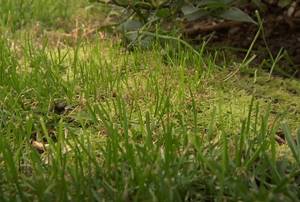
Excessive watering leads to moss growth. Another reason for the appearance of moss is acidification of the area or it is in the shade. This can be corrected with certain agricultural techniques. We deoxidize the soil with dolomite flour, wood ash, and add fertilizers. Aerating the soil also helps to cope with this problem.
Additional watering will be required after fertilizing, mowing, and during active growth. Closer to winter, watering is stopped altogether.
Lawn aeration in summer
The frequency of aeration in summer depends on weather conditions and the type of soil, how compacted and moist it will be. Thus, sandy soils require loosening less frequently than heavy clay soils. And the soil under the seed soil is less compacted than under the rolled soil.
Experts recommend piercing the turf in the summer 2 times a month if intensive grass growth occurs with less intensive trampling. Or after every third mowing in a temperate climate and when precipitation does not exceed normal.
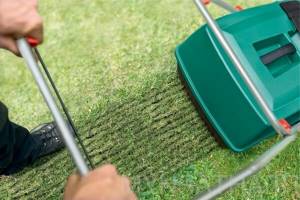
In rainy summers, when the soil is too wet, aeration can even be harmful. Because water will stagnate in the punctures, which can lead to rotting of the root system. It is better to wait until the soil dries and then start piercing the turf.
Seasonal work plan
Spring
After the snow cover melts, the soil should dry out. Once this has happened, you can begin scarification, aeration and application of spring fertilizers.
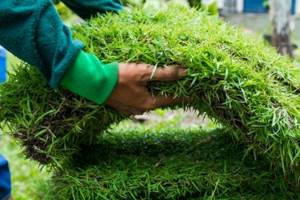
Also, in the spring, the lawn is sown and leveled, and after germination and active growth, it is mowed for the first time.
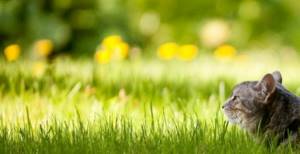
Summer
In summer, the lawn needs timely watering, mowing, fertilizing (mid-season), and aeration.
Autumn
Lawn care in the fall involves sowing grass, fertilizing with phosphorus and potassium fertilizers, and mulching. Aeration before the onset of rains will protect the meadow from ice crust.

In November, the last cutting is carried out, leaving 8 cm of grass. Scarification is carried out more often, clearing the lawn of leaves as necessary.

Preparing the lawn for winter involves mulching the turf and covering it with a special film (if the coating requires it).
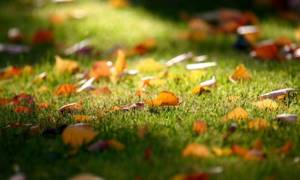
Winter
At this time of year, your lawn needs rest. Winter lawn care is not difficult - you just don’t need to walk across the meadow before snow appears, and also remove ice.
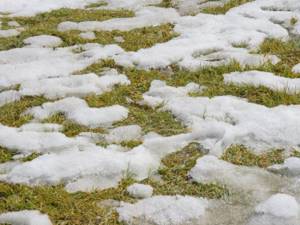
Preparing the lawn for winter in the fall
In the second half of August - early September, the lawn is mowed, fertilized for the last time, and after that you can let it live its own life. Of course, the end of intensive care directly depends on the weather. It’s no secret that in current realities, summer continues into September.
Landscape designers recommend using such a technique at this time - a canopy. The lawn is covered with a 3-4 cm layer of peat mixed with horse manure. Then in the spring it is removed before the plants begin to grow. This is a good blanket that will protect the grass from disease and damping off.
Sometimes autumn can be quite long and warm and we don’t know when the first snow will fall. Therefore, you need to carefully monitor the grass cover and monitor the weather report. If the grass becomes overgrown, more than 10 cm, it needs to be mowed. It should go under snow no more than 5 cm high.

Dear readers, everyone understands that with proper care, a beautiful and well-groomed lawn will delight you for a long time. In order for it to delight you with its greenery for many years, you must follow these basic rules when planting and caring for it. I hope these tips help you with that.
Good luck and all the best!

